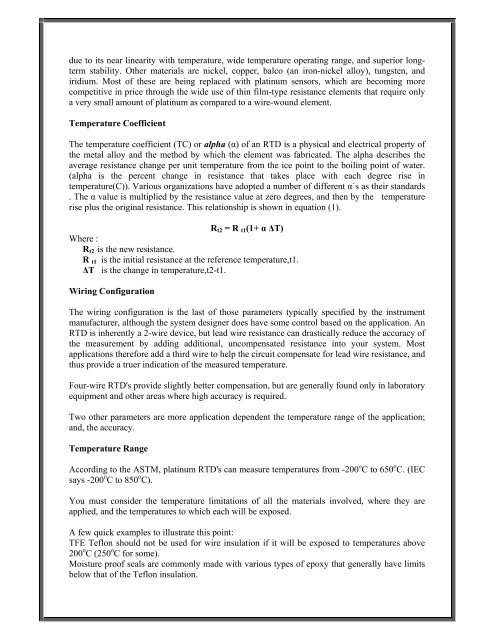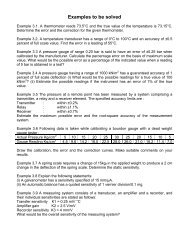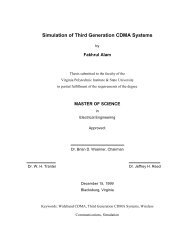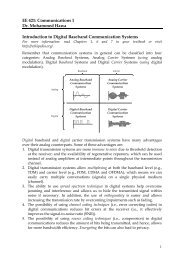Measurement Lab. Resistance Temperature Detector (RTD) - FET
Measurement Lab. Resistance Temperature Detector (RTD) - FET
Measurement Lab. Resistance Temperature Detector (RTD) - FET
You also want an ePaper? Increase the reach of your titles
YUMPU automatically turns print PDFs into web optimized ePapers that Google loves.
due to its near linearity with temperature, wide temperature operating range, and superior longtermstability. Other materials are nickel, copper, balco (an iron-nickel alloy), tungsten, andiridium. Most of these are being replaced with platinum sensors, which are becoming morecompetitive in price through the wide use of thin film-type resistance elements that require onlya very small amount of platinum as compared to a wire-wound element.<strong>Temperature</strong> CoefficientThe temperature coefficient (TC) or alpha (α) of an <strong>RTD</strong> is a physical and electrical property ofthe metal alloy and the method by which the element was fabricated. The alpha describes theaverage resistance change per unit temperature from the ice point to the boiling point of water.(alpha is the percent change in resistance that takes place with each degree rise intemperature(C)). Various organizations have adopted a number of different α`s as their standards. The α value is multiplied by the resistance value at zero degrees, and then by the temperaturerise plus the original resistance. This relationship is shown in equation (1).R t2 = R t1 (1+ α ΔT)Where :R t2 is the new resistance.R t1 is the initial resistance at the reference temperature,t1.ΔT is the change in temperature,t2-t1.Wiring ConfigurationThe wiring configuration is the last of those parameters typically specified by the instrumentmanufacturer, although the system designer does have some control based on the application. An<strong>RTD</strong> is inherently a 2-wire device, but lead wire resistance can drastically reduce the accuracy ofthe measurement by adding additional, uncompensated resistance into your system. Mostapplications therefore add a third wire to help the circuit compensate for lead wire resistance, andthus provide a truer indication of the measured temperature.Four-wire <strong>RTD</strong>'s provide slightly better compensation, but are generally found only in laboratoryequipment and other areas where high accuracy is required.Two other parameters are more application dependent the temperature range of the application;and, the accuracy.<strong>Temperature</strong> RangeAccording to the ASTM, platinum <strong>RTD</strong>'s can measure temperatures from -200 o C to 650 o C. (IECsays -200 o C to 850 o C).You must consider the temperature limitations of all the materials involved, where they areapplied, and the temperatures to which each will be exposed.A few quick examples to illustrate this point:TFE Teflon should not be used for wire insulation if it will be exposed to temperatures above200 o C (250 o C for some).Moisture proof seals are commonly made with various types of epoxy that generally have limitsbelow that of the Teflon insulation.
















